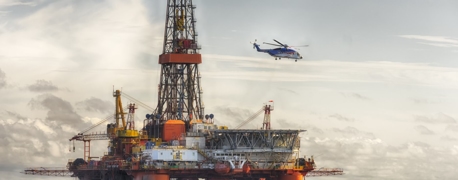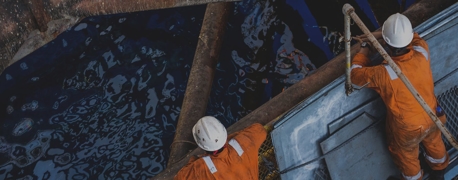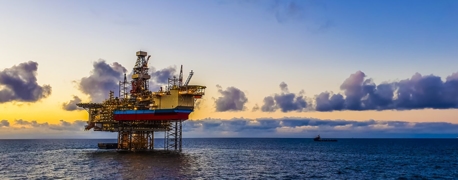The Dangers & Duties of 12 Jobs on an Offshore Oil Platform

When most people think of jobs on an offshore oil rig, they might think of roughnecks or drillers operating machinery, which of course is thoroughly accurate. However, it's not the full picture, as there are many jobs and roles that keep an offshore oil platform running that we don't often think about. These roles include chefs, housekeeping, and other support staff who are equally at risk in the event of a storm or explosion, and who have to navigate many of the same dangerous heights, precarious walking surfaces, and other risks that come with life on an oil rig.
Each job on an offshore oil rig comes with its own set of demands, rigors, and rewards. From working long hours to facing extreme weather conditions, the job of an offshore oil worker can be physically and mentally demanding, whatever role one fills. For many, the perks of the good salary and unique lifestyle make it worth the risks. In this article, we will take a broad look at the demands of 12 different jobs on an offshore oil platform, the rigors of their schedules, and the perks of their salaries while weighing that against the serious physical risks that they face.
The Demanding Work Schedule
First, let's take a look at what the typical work schedule looks like for anyone on an offshore oil rig. Many workers are on a six-month or one-year contract, and unlike oil sites on land, there isn't the option to go home every time you're off the clock. Instead, there's usually an onsite gym, theater, indoor sports facilities, computers, and more to occupy the time, but you're on the rig the entire time. During work hours, some positions are advertised as 8 hours a day with overtime, but typically positions are listed as 10 to 12 hours a day of work, with overtime being likely. This can easily add up to 80-hour workweeks, as rotations typically require 7, 14, or 28 days of work in one stretch, including holidays and weekends. Then that employee will have the same number of days off before starting the next stretch of work. On its own, this work schedule presents dangers of mental and physical fatigue. When combined with the occupational hazards of any offshore job, this relentless pace of work can lead to a heightened rate of serious injuries and even fatalities.
1. Pump Technicians: Ensuring Safe Pump Operations
As the name indicates, these professionals are responsible for the safe operation and maintenance of the oil pumps on an offshore rig. Pump technicians also handle the maintenance, repairs, and operation of chilled and hot water systems, expansion tanks, throttling valves, and more, and they also can handle pump valves in order to ensure an orderly filling of the storage tanks with crude oil. The national average salary for this position is $47,991, while some job postings list the hourly rate as being in the range of $18 to $40 an hour.
With the demanding work schedule, this can add up to an excellent paycheck. However, any job on an oil rig can be hazardous, and pump technicians are in the thick of everything, navigating the slick surfaces that could mean serious slip and fall injuries, pipes swinging around, or falling objects that can lead to serious struck-by accidents and broken bones, head trauma, spinal cord injuries, and more. There's also the constant presence of toxic chemicals that one mishap could force a pump technician to be exposed to.
2. Oil Rig Mechanic: Keeping Machines Running Smoothly
Another critical job that ensures drilling operations run smoothly and without interruption, the oil rig mechanic is responsible for installation, repairs, and maintenance of various machinery and vehicles, including pumps, oil-hauling vehicles, and elevators. They may also need to inspect helicopters before they take to the air.
While these mechanics can make $59,507 a year on average (or an hourly rate of $20-$30), oil rig mechanics are regularly required to work with equipment that can weigh between 70 and 230 pounds while also needing to apply up to 100 pounds of force to properly tighten or loosen bolts, for example. Lifting injuries can mean back sprains, pulled muscles, wrist and elbow injuries, spine injuries, and more. Heavy equipment can also lead to struck-by and caught-in accidents, such as winches, booms, and falling or swinging objects that can inflict serious injuries or knock someone overboard.
3. Crew Chief: Managing the Rig Operations
A crew chief oversees the team during their shifts to ensure everything runs smoothly and safely. The job involves scheduling shifts to make sure every role is covered, evaluating workers, ensuring the safety of rig equipment, and more. While this is a managerial position, the job is still onsite, so crew chiefs are also navigating the precarious terrain of the rig while carrying heavy equipment, still risking falls from great heights, being hit by falling objects, suffering electrical shock or exposure to toxic chemicals, and more. The role provides an average salary of $59,525, or hourly rates up to $30, but this job still demands on-call availability on top of long hours and a physically tough and precarious position.
4. Drill Operators: Managing Equipment
Operators are mainly responsible for the equipment used in oil drilling as well as the daily operations behind them. This can include handling equipment maintenance and transport, setting up the drill, and adjusting or stopping the drilling as needed. This role requires physical strength and endurance as one is working with heavy equipment and machinery. For instance, high-pressure lines can come loose, causing catastrophic or even fatal struck-by accidents, and with all the toxic chemicals involved, inhalation injuries can lead to chronic respiratory problems. The compensation for running these risks? The average annual salary for this role is $60,454, or an hourly rate of $25-$38.
5. Chefs: Taking the Stresses of the Kitchen on the High Seas
Working as an offshore oil rig chef can be a unique challenge. Buoyed by an average yearly salary of $62,270, chefs on offshore oil rigs are responsible for preparing meals, snacks, and drinks for everyone working on the oil rig, often working for the same extended periods of time as the other oil rig staff. In addition to cooking, chefs are also responsible for cleaning and maintaining the kitchen and equipment, planning daily meals, and ordering food.
While working as an offshore oil rig chef may not involve the same level of physical risk as other jobs on the rig, it still comes with its own set of risks and hazards. These can include the general risks of working in a kitchen, such as cuts, burns, and slips and falls, all combined with the added risks of being offshore, far from hospitals and emergency medical care. Especially when it comes to burn injuries that require surgeries or skin grafting, this level of care isn't available offshore, and the delays in treatment that come with needing to first be flown to land can mean any injuries sustained leave that much more damage and trauma. Working in a confined space on a moving oil rig can also be hazardous, especially when it comes to electrical hazards or exposure to dangerous gases.
6. Floorhands: One of the Key Roles for Any Crew
Floorhands are responsible for maintaining and assembling the equipment necessary for drilling operations on offshore oil rigs. Their duties include setting up and taking down equipment, moving heavy tools and equipment, and installing casing and tubing. The physically demanding nature of the job requires floorhands to climb, lift, balance, and perform other strenuous tasks regularly. In addition, floorhands are responsible for repairing, adjusting, servicing, and testing rig equipment.
For a salary of $62,950 a year on average, or a $25-$38 hourly rate, the job of a floorhand involves a range of occupational hazards. These risks include falls from heights, being struck by heavy equipment, and injuries from handling heavy machinery, such as crush injuries that could mean losing a finger, hand, or other body part. Working in confined spaces, exposure to hazardous chemicals, fires, and the risks associated with working in an offshore environment far from medical facilities are also concerns.
7. Derrickhands: Hauling, Unloading & More
A derrickhand plays a crucial role in drilling operations, overseeing the connection of drilling equipment and keeping pipes steady. Paid on average $65,366 a year, derrickhands can be responsible for everything from training new members of the drill team to maintaining drilling fluids and lubricating rig machinery. Hauling heavy pipes across the rig and working at heights are also part of the job. This means working long hours with the risks of falling from a great height, equipment or machinery malfunctions, exposure to dangerous chemicals and fumes, and more.
8. Motorman: Keeping the Rig & Vessel Operational
Motormen play a vital role in maintaining the operations of an offshore oil rig may need to handle everything from painting the rig to staying on top of changes in weather conditions. Their responsibilities include maintenance and repairs for the engine room, air compressors, pumps, portable water systems, and other critical equipment. They also may need to determine what is a safe load weight and inspect loads accordingly. Motormen perform physically demanding tasks, such as heavy lifting, stooping, and crawling, which can take a toll on their bodies over time even if there are no emergencies or incidents. Of course, hazards such as falls, electrical shocks, machine accidents, and more are always present. While there is on average a yearly salary of $65,947, this job requires a high level of commitment and dedication to keeping the rig and vessel operational.
9. Mechanical Engineer: Rig Equipment & Systems
The salary for a mechanical engineer on an offshore oil rig typically ranges from $87,106 to over $130,000. They may need to handle everything from the design and installation to the repairs for equipment such as pipelines, valves, turbines, and other equipment. These professionals may also be responsible for water, sanitary, draining, fuel oil, HVAC, and other systems on the rig. While mechanical engineers need to provide documentation on equipment designs, they often need to stoop, crawl, climb, and lift heavy objects to fulfill the hands-on duties of their role. While the paycheck is nice, they are often required to be on call 24/7 for emergency situations, and they face risks that include and aren't limited to electrical shocks, moving mechanical parts, working from heights, exposure to fumes, and extreme weather conditions.
10. Drilling Engineers: Designing & Implementing Oil Extraction Equipment
Drilling engineers play a crucial role in ensuring the safety, efficiency, and effectiveness of drilling operations on offshore oil rigs; they design the main purpose of the rig. They are responsible for researching and assessing drilling sites, selecting and overseeing drilling equipment, and analyzing drilling designs to improve safety and reduce costs. They use technical knowledge, analytical skills, and even programming to develop new techniques and technology that will help increase efficiency and reduce risks.
In addition to providing documentation for everything, drilling engineers often must be available 24/7 to provide technical support for rig operations. Despite this role involving paperwork and other office tasks, and not the physical labor of the rig, drilling engineers are still onsite and therefore face the threats of falling objects, electrical hazards, and weather risks. That said, a typical salary range of $79,273 to $130,000 a year may make it worth the risks to those who are qualified to take on this role.
11. Offshore Medic: Life Support on the Oil Rig
Offshore medics are tasked with health evaluations, general patient care, and of course, emergency medical responses in remote, sparsely supplied conditions, sparse at least compared to medical offices and hospitals on land. The national average wage for an offshore medic is $33 an hour, but their being on an oil rig means that medics themselves face ergonomic hazards, electrical hazards, and exposure to harsh weather conditions. Especially in the role of paramedic, they may also be required to do heavy lifting and use extrication tools to reach patients in tough spots, as well as handle machinery in the vicinity in order to ensure patient safety after an incident. When this team is the sole medical response for emergencies, medics may be required to enter dangerous situations with very minimal backup.
12. Roustabout (or Offshore Housekeeping/Steward)
While this position can go under differing job titles on advertisements, the job of an offshore steward or roustabout essentially includes the housekeeping on an oil rig, everything from keeping living quarters and common areas clean as well as handling the laundry, stocking of supplies, and more. For a roustabout, the role will usually require more than cleaning, requiring a variety of maintenance tasks as well, from both cleaning and painting equipment to handling trash disposal, helping with heavy loads, and more. They may also have to take over for floorhands, derrickhands, a motorman, and others as needed. This can require a person to work at great heights, take the risks of frequent heavy lifting, navigate the hazards of rig in all types of weather.
A roustabout can make on average $57,670 a year, while in the upper limit for salaries they could make an average of $1,700 a week. This variable, versatile position depends on the employer involved, but whatever the specifics, roustabouts will often find themselves all over the oil rig at any given point, facing just about any and all of the risks that being on an oil rig can present.
High Risk, High Reward?
Many of the risks listed in each section are not unique to those roles. Simply being present on an oil rig can mean running those same risks for any worker on the platform, though of course, certain roles are more physically strenuous and will require more regular proximity to certain risks than others. This also was not a comprehensive look at the jobs that make an oil rig function, nor was this an exhaustive look at the duties and risks that come with these positions. This was just a limited glance at a hazardous worksite.
Working aboard an offshore oil rig can be quite lucrative, but it's certainly not for everyone. The job demands grueling hours, which can lead to bone and muscle injuries from the demanding, repetitive work, even in the absence of any incidents. With the ever-present safety and health risks, being far from shore also means that adequate medical help may not be accessible. However, for those who are up for the challenges, the unique lifestyle and income opportunities may be worth it. It's just all the more important to ensure that a person, whatever the role, has an employer that provides proper risk mitigation and enforces safety precautions. Far too often, the injuries and accidents that oil rig workers face would have been preventable if companies had only fulfilled their duties and roles to fund adequate equipment and safety procedures.
- Categories


